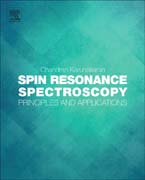
Spin Resonance Spectroscopy: Principles and Applications presents the principles, recent advancements and applications of nuclear magnetic resonance (NMR) and electron paramagnetic resonance (EPR) in a single multi-disciplinary reference. Spin resonance spectroscopic techniques through NMR and EPR are widely used by chemists, physicists, biologists and medicinal chemists. This book addresses the need for new spin resonance spectroscopy content while also presenting the principles, recent advancements and applications of NMR and EPR simultaneously. Ideal for researchers and students alike, the book provides a single source of NMR and EPR applications using a dynamic, holistic and multi-disciplinary approach. Presents a highly interdisciplinary approach by including NMR and EPR applications in chemistry, physics, biology and biotechnology Addresses both NMR and EPR, making its concepts and applications implementable in multiple resonance environments and core scientific disciplines Features a broad range of methods, examples and illustrations for both NMR and EPR to aid in retention and underscore key concepts INDICE: Unit 1: Principle NMR and pulsed NMR Introduction - Spin Magnetic properties - Resonance condition - Larmor Frequency - NMR instrumentation - comparison of NMR & EPR - chemical shift - spin-spin coupling - Coupling constant - first and second order spectra - simplification of complex spectra - Boltzmann Statistics - Pulsed NMR - Basic principle of FT technique - Relaxation process - Bloch equations - Relaxation times - Line shape and line width analysis Unit 2: 1H and 13C NMR spectroscopy Interpretation of 1H NMR - assignment of signals - influence of factors on chemical shift of protons - 13C NMR - spin decoupling - double resonance - Nuclear Overhauser Effect - Off Resonance Decoupling - CIDNP - 13C assignment of signals - additivity rule - calculation of chemical shifts for aromatic and aliphatic compounds - 2D NMR -- DEPT 13C - 13C correlation COSY, HETCOR, NOE & NOSEY- multidimensional NMR Unit 3: Applications of NMR Applications of 31P, 19F and 15N - NMR spectroscopy used in structural problem - NMR of fluxional molecules - evaluation of rate constants - solid state NMR - magic angle spinning - NMR of paramagnetic molecules - contact shifts and shift reagents - NMR imaging - contrast agents Unit 4: EPR Spectroscopy Principle of EPR - instrumentation - total spin Hamiltonian - presentation of the spectrum - hyperfine splitting - super hyperfine structure - EPR of hydrogen atom - splitting in isotropic systems involving more than one nucleus - EPR spectra of free radicals in solution - methyl radical, benzene anion, p-benzosemiquinone radical anion, p- nitrobenzoate dianion and naphthalene anion - Evaluation of g and A tensors - factors affecting the magnitude of g values -- anisotropy - zero field splitting - Kramer's theory & degeneracy - triplet EPR Unit 5: Application and advanced EPR Application of EPR in transition metal complexes VO2+ Fe3+ Co2+ ,Mn2+, Ni2+ and bis-salicylaldimine copper (II) - Jahn-Teller theory & distortion studies in Cu(II) complexes - evaluation of spin - orbital coupling constant - exchange coupled EPR - multi resonance EPR - cw and pulsed EPR and ENDOR - MEMS and DAVIS - ESEEM - HYSCORE - ESR Spin trapping - spin labeling - EPR imaging
- ISBN: 978-0-12-813608-9
- Editorial: Elsevier
- Encuadernacion: Rústica
- Páginas: 400
- Fecha Publicación: 15/01/2018
- Nº Volúmenes: 1
- Idioma: Inglés
